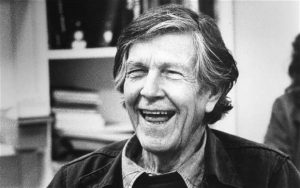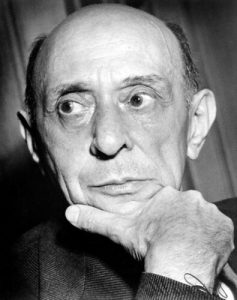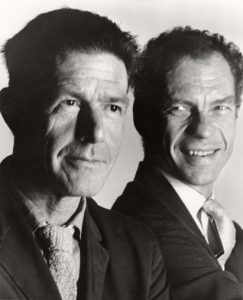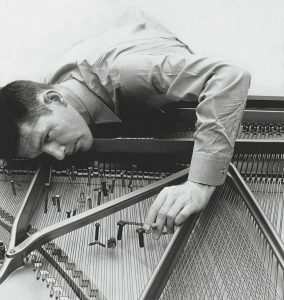
On August 12, 1992 – 27 years ago today – the American composer, inventor, philosopher, facilitator, agent provocateur, shaman, clown, and guru, John Cage died in New York City at the age of 79.
Background. My May 14, 2019 Dr. Bob Prescribes post (which can be found on Patreon; if you’ve not yet subscribed, please do so!) featured the American composer Henry Cowell (1897-1965). Cowell, who grew up in the San Francisco Bay Area, was a musical polymath, a Universalist, a walking encyclopedia: someone who was as deeply knowledgeable of so-called “world music” (particularly central and east Asian music) as he was of Western art music and folk music.

Cowell was a charismatic human dynamo, and a composer and teacher of genius, someone whose pioneering impact on the American musical community in the 1920s and 1930s was singular. Among the many young American musicians on whom Cowell had a decisive impact was a native Los Angelino and graduate of Los Angeles High School named John Milton Cage, Jr. According to Cage, Cowell was nothing less than “the open sesame for new music in America.”
Cage took Cowell’s teachings and beliefs about the universal, pan-cultural nature of music and sound to an entirely new level, and in doing so changed forever the way twentieth-century composers thought about music.
(Pardon me a brief personal comment. To my adored East Coast academic colleagues who, upon reading the paragraph above, will only roll their eyes and shake their heads: I would remind you that Ivy League music departments and their offshoots across the U.S. constitute but a tiny part of the international musical and artistic community, which was in fact deeply – even profoundly – influenced by Cage during the mid and late-twentieth century. To my beloved readers who only know Cage from such works as 4’33” and assume that he was a charlatan, well, he was most certainly not, as even a cursory examination of his music for prepared piano will bear out. He was in fact a brilliant, personable, extremely funny man, someone who refused to live by any rules other than his own. Knowing Cage as I do, I’ve no doubt that if someone called him a “charlatan”, he’d put an index finger in the air, smile his big toothy grin, and say something on the lines of “Yes, but a charlatan of genius!”)

Despite some early piano lessons, Cage came to music relatively late in life, after having worked for a time as an architectural apprentice. Along with Henry Cowell, Cage’s most important composition teacher was – of all people – Arnold Schoenberg, who was teaching at U.C.L.A. when Cage studied with him and who Cage worshipped. In a lecture entitled “Indeterminacy”, Cage told this story:
“When Schoenberg asked me whether I would devote my life to music, I said, ‘Of course.’ After I had been studying with him for two years, Schoenberg said, ‘In order to write music, you must have a feeling for harmony.’ I explained to him that I had no feeling for harmony. He then said that I would always encounter an obstacle; that it would be as though I came to a wall through which I could not pass. I said, ‘In that case I will devote my life to beating my head against that wall.’”

Schoenberg didn’t consider Cage much of a composer, but he did consider him to be “an inventor of genius.” And that Cage was. Drawn increasingly to dance and Indonesian/Balinese gamelan-inspired percussion music, Cage created a percussion orchestra in Seattle in 1938 before moving to San Francisco in 1939, where for two years he and Lou Harrison (another Cowell groupie) gave concerts of percussion music. In 1941, Cage went to Chicago where he taught, organized percussion concerts, and accompanied dancers. Finally, in 1942, he arrived in New York, which became “home base” for the rest of his life.

In April of 1944, Merce Cunningham (1919-2009) – at the time a dancer in Martha Graham’s dance company – presented his first solo concert in association with Cage. The professional relationship between Cage and Cunningham continued for decades, and Cage eventually became the music director for Merce Cunningham’s dance company. Even more importantly, they became life partners following Cage’s divorce from his wife, the surrealist sculptor Xenia Kashevaroff Cage in 1946 (or 1945; no one seems to know for sure!).
Almost all the music Cage composed from the late 1930s through the 1940s was for various percussion ensembles and for prepared piano. Inspired equally by Henry Cowell’s audacious use of the piano and by gamelan, Cage began vandalizing pianos in a very special way, by placing paper clips, screws and bolts (of different sizes), rubber erasers on and between certain strings, thumb-tack in hammers, weaving paper and other objects through strings, and so forth. Cage called such an instrument a “prepared piano”, although some clever critic came up with the alternative designation of “Well-Tampered Clavier”.

Cage carefully charted how a piano should be prepared, as different works demanded different preparations. A prepared piano is, in fact, a one-person percussion orchestra. Cage’s first composition for prepared piano was his Bacchanale (of 1938). By the late 1940s he had mastered the medium, and his Sonatas and Interludes for prepared piano, composed between 1946 and 1948, is a masterwork of complex rhythmic patterns, amazing timbres, wry humor, and pure, joyful imagination.
Here you go: in the spirit of Dr. Bob Prescribes, I will recommend a recording: pianist Gerard Fremy, on the Etcetera label.
Cage’s Sonatas and Interludes for prepared piano – with their long, static rhythmic patterns and vaguely pentatonic pitch material – reflect his developing interest in and commitment to East Asian and Indian musical ideals, particularly in regard to time. In Indian music, for example, time is not so much linear (as in Euro-American music) as it is existential; music is not so much narrative – meaning goal-oriented – as it is “in the moment”. “Paradise/Nirvana” (as in Euro-American meaning resolution and conclusion) is not something to aspire to but something that exists in every moment.
Cage’s music for prepared piano made even the great-insufferable-one, Pierre Boulez, sit up and take notice. Writing in 1952, Boulez had this to say about Cage:
“I do not want to pursue this study of present-day perspectives in music without mentioning the names of Olivier Messiaen and John Cage. They alone are the exceptions that I pointed out in the language’s acquisitions after Webern, Stravinsky, Berg, and Schoenberg, [Cage] by his prospecting among complex sounds, complexes of sounds, and also in the rhythmic domain.

“John Cage has given us the proof that it is possible to create non-tempered sound-spaces using existing instruments. Thus, his use of the prepared piano is not merely an unexpected aspect of a piano-percussion in which the harmonic table is invaded by unexampled, metalizing vegetation. [TIME OUT! We must all love that phrase, “unexampled, metalizing vegetation” even if it is the product of a bad translation from Boulez’ native French, because to look inside a prepared piano is to see a jumble of unexampled metallic vegetation]. It is much more a questioning of the acoustic notions stabilized little by little in the course of the evolution of Occidental [Western] music. The direction of John Cage’s experiments is too near that of my own for me not to take note of it.”
As was typical with Boulez, his enthusiasm for Cage would be short lived. Because even as Boulez was writing these words, Cage was in the process of purposely abandoning the traditional role of the composer as “creator” in favor of becoming a “facilitator of the unexpected”. His discovery and study of Hindu aesthetics, Taoism, and Zen Buddhism led him to the conclusion that Western art had taken a wrong turn during the fourteenth century when the intrusion of personal “ego” led artists, writers, and composers to begin “signing” their work. Cage came to believe that this self-expressive attitude was “heretical” to the true nature of art, declaring that “My purpose is to eliminate purpose.” For Cage, the sounds (and silences) of nature, people, and machines became his ever-changing orchestra. Starting in 1951 with his Music of Changes for solo piano (arguably Cage’s last “musical composition”), he abandoned any pretense towards self-expressive art:
“One may give up the desire to control sound, clear his mind of music, and set about discovering the means to let sounds be themselves rather than vehicles for man-made theories or expressions of human sentiments. . . . I try to arrange my composing so that I won’t have any knowledge of what might happen. . . . I believe that by eliminating purpose, what I call awareness increases.”
In order to completely divorce himself from the music he “created”, Cage turned to all sorts of chance processes for making compositional “decisions”: throwing dice, flipping coins, and tossing sticks marked with numbers, among them. Music in which certain aspects were left to chance came to be referred to as aleatoric music or musical aleatory, a term created from the Latin word alea, meaning “dice”. But even more, Cage wanted his music to be indeterminate: completely unpredictable, divorced entirely from any willful act on his part. This is pure Zen Buddhism, which was very chi-chi among American and European intellectuals during the 1940s and 1950s, a reaction, so it has been said, to the combined traumas of the cold war and the threat of nuclear annihilation. “Zen” – Japanese for “meditation” – is a discipline that seeks spiritual illumination through suppression of the individual ego and the rejection of rational thought. Only thus divested of the “illusions” that are the “self” and “logic” can the individual become one with the troposphere (or some such) and gain enlightenment.
That definition of Zen goes long way towards explaining Cage’s artistic intent (or “studied-lack-of-intent”, as the case may be). Cage spent the better part of his career creating strategies that would produce “music” that was entirely free from his control.

It’s not necessary to catalog Cage’s wild and wacky “musical” happenings/séances/circuses/multi-media extravaganzas (or whatever we choose to call them). The important point is that for John Cage, as both a man and musician, anything was possible at any time. The depth and power of his convictions (to say nothing for his imagination, humor and geniality) gave them extraordinary moral weight. As a result, Cage managed to get away with doing things that no one else could possibly have gotten away with. In doing so, he made the compositional community think about things musical – the nature of time, sound, silence, creativity, the whole musical-experiential shebang – in ways we might otherwise never have considered. Until 1951, John Cage was a composer. After 1951, it would be better to consider him a combination inventor, philosopher, facilitator, agent provocateur, shaman, clown, and guru: a person unique in twentieth-century Western music history.
For more on John Cage and the music of the twentieth century, I would humbly direct your attention to my Great Courses survey, The Great Music of the Twentieth Century, which can be sampled and downloaded here at RobertGreenbergMusic.com.
Listen on the Music History Monday Podcast
Podcast: Play in new window
Subscribe: Apple Podcasts | Spotify | Pandora | iHeartRadio | RSS | More
